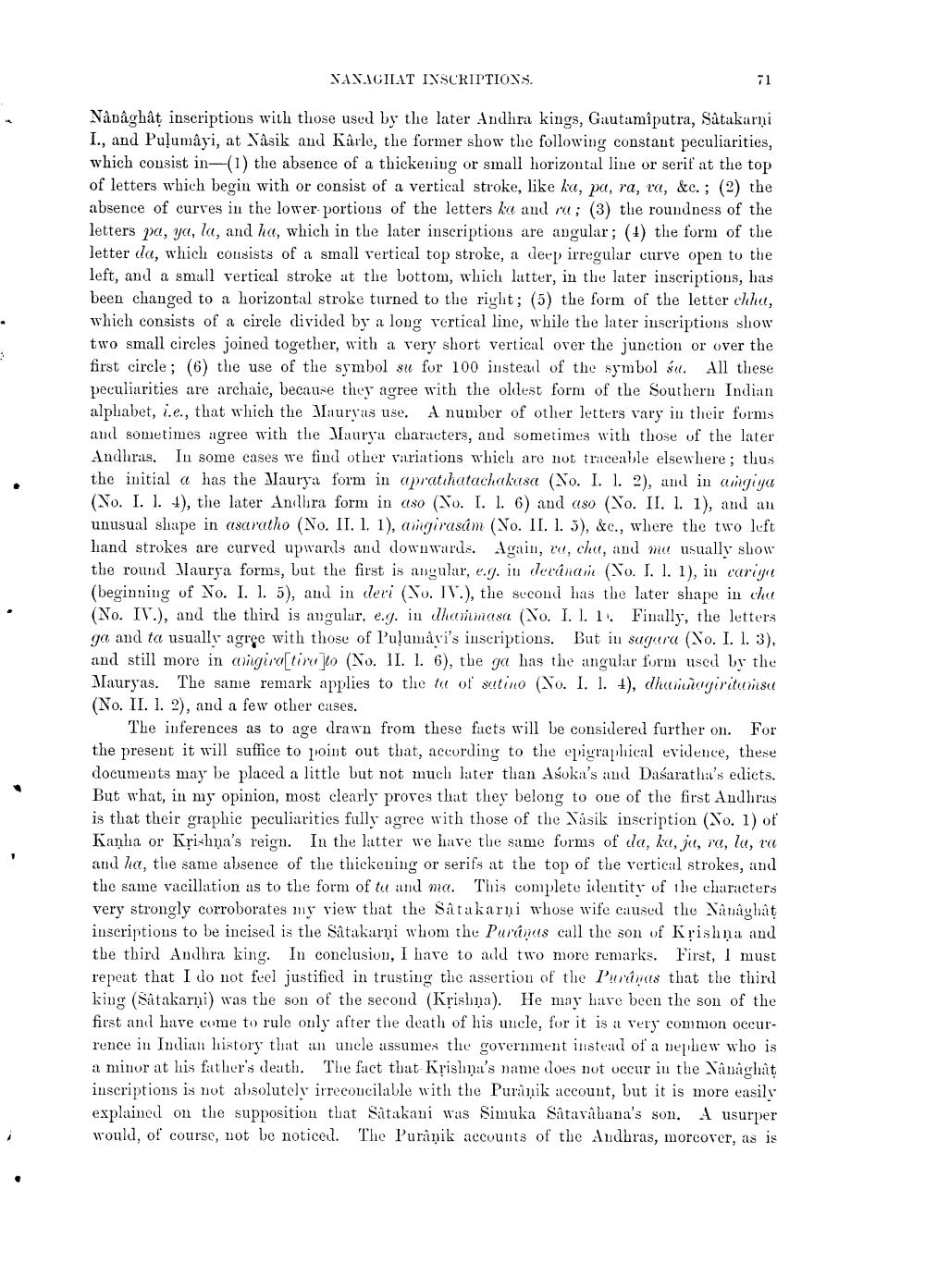________________
NAXAGHIAT IXSCRIPTIOXS.
Nânâghât inscriptions with those used by the later Andhra kings, Gautamiputra, Satakarni I., and Puļumâyi, at Nasik and Karle, the former show the following constant peculiarities, which consist in-(1) the absence of a thickening or small horizontal line or serif' at the top of letters which begin with or consist of a vertical stroke, like ka, pa, ra, va, &c. ; (2) the absence of curves in the lower portions of the letters ka and ru; (3) the roundness of the letters pa, ya, la, and ha, which in the later inscriptions are angular; (1) the form of the letter da, which consists of a small vertical top stroke, a deep irregular curve open to the left, and a small vertical stroke at the bottom, which latter, in the later inscriptions, has been changed to a horizontal stroke turned to the right; (5) the form of the letter chhu, which consists of a circle divided by a long vertical line, while the later inscriptions show two small circles joined together, with a very short vertical over the junction or over the first circle; (6) the use of the symbol su for 100 instead of the symbol su. All these peculiarities are archaic, because they agree with the oldest form of the Southern Indian alphabet, i.e., that which the Mauryas use. A number of other letters vary in their forms and sometimes agree with the Maurya characters, and sometimes with those of the later Andhras. In some cases we find other variations which are not traceable elsewhere; thus the initial a has the Maurya form in pratihatachakusa (No. I. 1. 2), and in aingiya (No. I. 1. 4), the later Anilhra form in aso (No. I. 1. 6) and aso (No. II. 1. 1), and an unusual shape in asaratho (No. II. 1. 1), aingirasam (No. II. 1. 5), &c., where the two left hand strokes are curved upwards and downwards. Again, wu, chu, and mu usually show the round Maurya forns, but the first is angular, e.g. in derânarie (No. I. 1. 1), in cariya (beginning of No. I. 1. 5), and in deri (No. IV.), the second has the later shape in chu (No. IV.), and the third is angular, e.g. in dharmasa (No. I. 1. 1. Finally, the letters ga and ta usually agree with those of Pulumâri's inscriptions. But in sugara (No. I. 1. 3), and still more in aningira[tire ]to (No. II. 1. 6), the ga has the angular form used by the Mauryas. The same remark applies to the tu of satino (No. I. 1. 4), dhunagiritansu (No. II. 1. 2), and a few other cases.
The inferences as to age drawn from these facts will be considered further on. For the present it will suffice to point out that, according to the epigraphical evidence, these documents may be placed a little but not much later than Asoka's and Dasaratha's edicts. But what, in my opinion, most clearly proves that they belong to one of the first Audhras is that their graphic peculiarities fully agree with those of the Násik inscription (No. 1) of Kaņla or Krishna's reign. In the latter we have the same forms of da, ka, ja, ra, la, ra and ha, the same absence of the thickening or serifs at the top of the vertical strokes, and the same vacillation as to the form of tu and ma. This complete identity of the characters very strongly corroborates my view that the Satakarni whose wife caused the Nànågbåt inscriptions to be incised is the Satakarni whom the Puranas call the son of Krishna and the third Andhra king. In conclusion, I have to add two more remarks. First, I must repeat that I do not feel justified in trusting the assertion of the Puranas that the third king (Satakarņi) was the son of the second (Krislina). He may have been the son of the first and have come to rule only after the death of his uncle, for it is a very common occurrence in Indian history that an unele assumes the government instead of a nephew who is a minor at his father's death. The fact that Krislina's name does not occur in the Nânåghat inscriptions is not absolutely irreconcilable with the Puranik account, but it is more easily explained on the supposition that Satakani was Simuka Satavahana's son. A usurper would, of course, not be noticed. The Puranik accounts of the Audhras, moreover, as is




